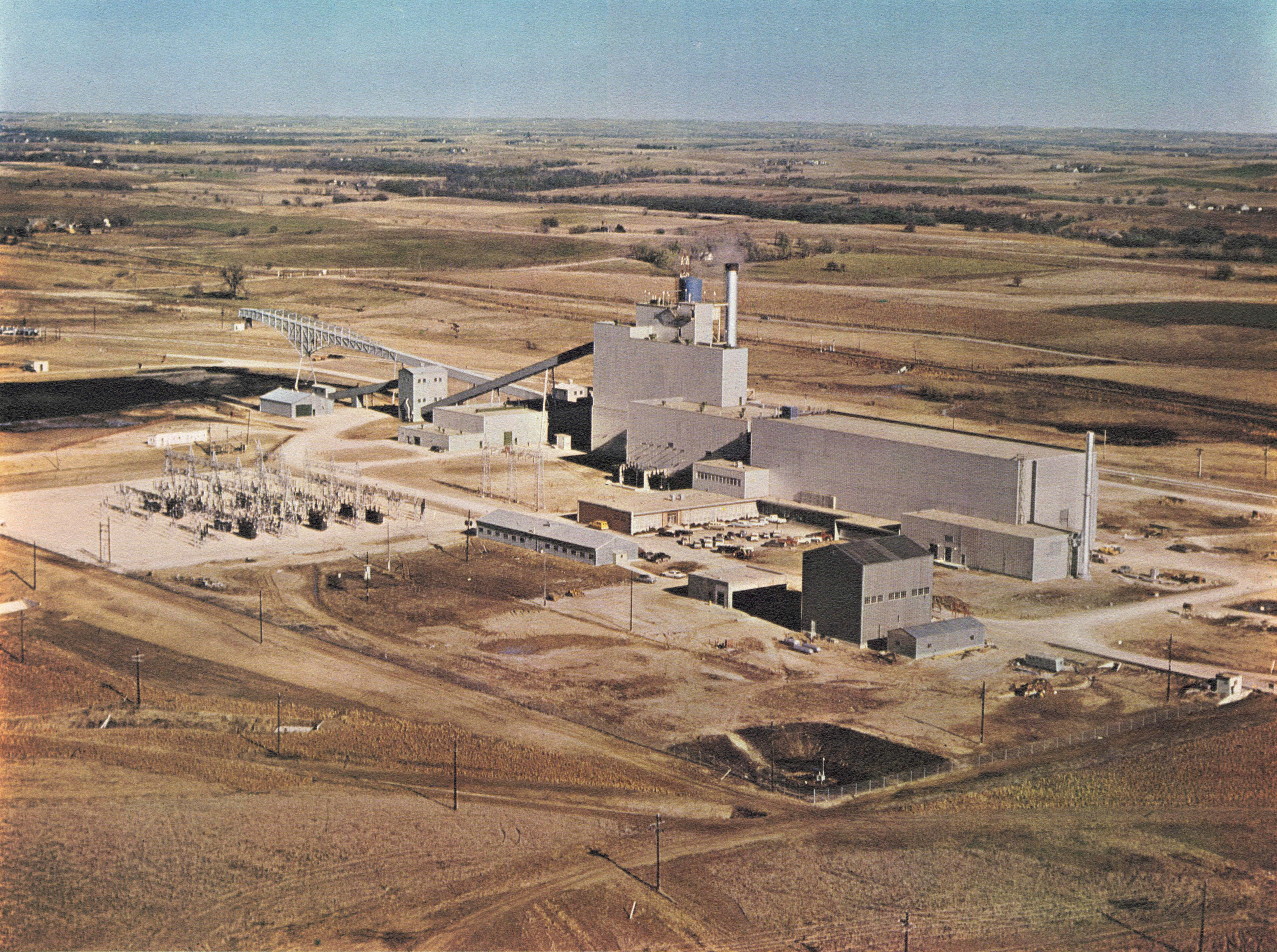|
Sheldon Power Station
Sheldon Power Station is a coal-fired power station located near Hallam, Nebraska. It is the site of the former Hallam Nuclear Generating Station which operated from 1962 to 1964. Plant information Construction of Sheldon Station began in 1958—first as a combined nuclear and conventional facility. It was the pioneer sodium graphite nuclear power plant in the nation. The nuclear portion of the plant began operating early in 1963 and was at full power by July, 1963. However, this portion of the facility was ordered decommissioned by the former Atomic Energy Commission (AEC), now the Nuclear Regulatory Commission The Nuclear Regulatory Commission (NRC) is an independent agency of the United States government tasked with protecting public health and safety related to nuclear energy. Established by the Energy Reorganization Act of 1974, the NRC began operat ..., in 1964. The AEC, which built the atomic plant, said it had garnered all the information it wanted about the sodium gra ... [...More Info...] [...Related Items...] OR: [Wikipedia] [Google] [Baidu] |
Hallam, Nebraska
Hallam is a village in Lancaster County, Nebraska, United States. It is part of the Lincoln, Nebraska Metropolitan Statistical Area. The population was 213 at the 2010 census. History Hallam was platted in 1892 when the Chicago, Rock Island and Pacific Railroad was extended to that point. The land was sold by Frederick Schneider, who was asked to name the village. However, Schneider's proposals were already names of towns in Nebraska, so the first landowner in the village, Jacob Schadd, was given the honor of naming the settlement. Schadd suggested Hallau, after his hometown in Switzerland. However, due to a transcription error at the post office, the name was recorded as Hallam rather than Hallau, similar to the error which altered Norfork, Nebraska, to Norfolk, Nebraska. Mrs. Maggie Classen owned several lots in Hallam, unusual for a woman in the 1890s, upon which were built the telephone office and a doctor's office. By the early 1900s, Hallam featured a bank, a hardware stor ... [...More Info...] [...Related Items...] OR: [Wikipedia] [Google] [Baidu] |
Hallam Nuclear Generating Station
The Hallam Nuclear Power Facility (HNPF) in Nebraska was a 75 MWe sodium-cooled graphite-moderated nuclear power plant built by Atomics International and operated by Consumers Public Power District of Nebraska. It was built in tandem with and co-located with a conventional coal-fired power station, the Sheldon Power Station. The facility featured a shared turbo generator that could accept steam from either heat source, and a shared control room. Full power was achieved in July 1963. The facility shut down on September 27, 1964 to resolve reactor problems. In May 1966, Consumers Public Power District rejected their option to purchase the facility from the Atomic Energy Commission (AEC). In response, the AEC announced its plan to decommission the facility in June, 1966. The facility operated for 6,271 hours and generated 192,458,000 kW-hrs of electric power. It was located near Hallam, about 25 miles southwest of Lincoln. Description The sodium-cooled graphite-moderated rea ... [...More Info...] [...Related Items...] OR: [Wikipedia] [Google] [Baidu] |
Nuclear Regulatory Commission
The Nuclear Regulatory Commission (NRC) is an independent agency of the United States government tasked with protecting public health and safety related to nuclear energy. Established by the Energy Reorganization Act of 1974, the NRC began operations on January 19, 1975, as one of two successor agencies to the United States Atomic Energy Commission. Its functions include overseeing reactor safety and security, administering reactor licensing and renewal, licensing radioactive materials, radionuclide safety, and managing the storage, security, recycling, and disposal of spent fuel. History Prior to 1975 the Atomic Energy Commission was in charge of matters regarding radionuclides. The AEC was dissolved, because it was perceived as unduly favoring the industry it was charged with regulating.John Byrne and Steven M. Hoffman (1996). ''Governing the Atom: The Politics of Risk'', Transaction Publishers, p. 163. The NRC was formed as an independent commission to oversee nuclear ene ... [...More Info...] [...Related Items...] OR: [Wikipedia] [Google] [Baidu] |
Electrostatic Precipitator
An electrostatic precipitator (ESP) is a filterless device that removes fine particles, like dust and smoke, from a flowing gas using the force of an induced electrostatic charge minimally impeding the flow of gases through the unit. In contrast to wet scrubbers, which apply energy directly to the flowing fluid medium, an ESP applies energy only to the particulate matter being collected and therefore is very efficient in its consumption of energy (in the form of electricity). Invention of the electrostatic precipitator The first use of corona discharge to remove particles from an aerosol was by Hohlfeld in 1824. However, it was not commercialized until almost a century later. In 1907 Frederick Gardner Cottrell, a professor of chemistry at the University of California, Berkeley, applied for a patent on a device for charging particles and then collecting them through electrostatic attraction—the first electrostatic precipitator. Cottrell first applied the device to the col ... [...More Info...] [...Related Items...] OR: [Wikipedia] [Google] [Baidu] |
Nebraska Public Power District
Nebraska Public Power District (NPPD) is the largest electric utility in the state of Nebraska, serving all or parts of 84 (of 93) counties. It was formed on January 1, 1970, when Consumers Public Power District, Platte Valley Public Power and Irrigation District (PVPPID) and Nebraska Public Power System merged to become Nebraska Public Power District. NPPD's predecessors were created through the efforts of the Nebraska legislature and financial agent Guy L. Myers as part of a system where all the investor-owned utilities operating in the state of Nebraska (Nebraska Power Co., Central Power Co., Southern Nebraska Power Co., et al.) were condemned and their properties turned over to 'public power districts' being created at the time (early 1940s). NPPD is a public corporation and political subdivision of the state of Nebraska. The utility is governed by an 11-member Board of Directors, who are popularly elected from NPPD's chartered territory. NPPD's revenue is mainly derived from w ... [...More Info...] [...Related Items...] OR: [Wikipedia] [Google] [Baidu] |
Lincoln, Nebraska
Lincoln is the capital city of the U.S. state of Nebraska and the county seat of Lancaster County. The city covers with a population of 292,657 in 2021. It is the second-most populous city in Nebraska and the 73rd-largest in the United States. The city is the economic and cultural anchor of a substantially larger metropolitan area in the southeastern part of the state called the Lincoln Metropolitan and Lincoln- Beatrice Combined Statistical Areas. The statistical area is home to 361,921 people, making it the 104th-largest combined statistical area in the United States. The city was founded in 1856 as the village of Lancaster on the wild salt marshes and arroyos of what was to become Lancaster County. Renamed after President Abraham Lincoln, it became Nebraska's state capital in 1869. The Bertram G. Goodhue–designed state capitol building was completed in 1932, and is the second tallest capitol in the United States. As the city is the seat of government for the state ... [...More Info...] [...Related Items...] OR: [Wikipedia] [Google] [Baidu] |
Lancaster County, Nebraska
Lancaster County is a county located in the U.S. state of Nebraska. As of the 2020 United States Census, the population was 322,608, making it the second-most populous county in Nebraska. Its county seat is Lincoln, the state capital. The county was created in 1859. Lancaster County is part of the Lincoln, NE Metropolitan Statistical Area. In the Nebraska license plate system, Lancaster County was represented by the prefix 2 (it had the second-largest number of vehicles registered in the state when the license plate system was established in 1922). In 2002, the state discontinued the 1922 system in Lancaster, Douglas and Sarpy counties. Geography According to the US Census Bureau, the county has a total area of , of which is land and (1.0%) is water. Major highways * Interstate 80 * Interstate 180 * U.S. Highway 6 * U.S. Highway 34 * U.S. Highway 77 * Nebraska Highway 2 * Nebraska Highway 33 * Nebraska Highway 43 * Nebraska Highway 79 Climate In 2004, Lancaste ... [...More Info...] [...Related Items...] OR: [Wikipedia] [Google] [Baidu] |
Cooper Nuclear Station
Cooper Nuclear Station (CNS) is a boiling water reactor (BWR) type nuclear power plant located on a site near Brownville, Nebraska between Missouri River mile markers 532.9 and 532.5, on Nebraska's border with Missouri. It is the largest single-unit electrical generator in Nebraska. Description CNS is owned and operated by the Nebraska Public Power District (NPPD), a political subdivision of the state of Nebraska. The facility is named after Humboldt natives Guy Cooper Jr., and Guy Cooper Sr. The senior Cooper's father, O. A. Cooper, built the first electrical plant in Humboldt in 1890; the two Guy Coopers served a total of 27 years on the board of NPPD and its predecessor agency, Consumers Public Power District. CNS was first put into operation in July 1974 and generates approximately 800 megawatts (MWe) of electricity. The plant consists of a General Electric BWR/4 series reactor plant and a Westinghouse turbine generator. The plant has a Mark I containment system ... [...More Info...] [...Related Items...] OR: [Wikipedia] [Google] [Baidu] |
Babcock & Wilcox
Babcock & Wilcox is an American renewable, environmental and thermal energy technologies and service provider that is active and has operations in many international markets across the globe with its headquarters in Akron, Ohio, USA. Historically, the company is best known for their steam boilers. Background The company was founded in 1867 in Providence, Rhode Island, by partners Stephen Wilcox and George Babcock to manufacture and market Wilcox's patented water-tube boiler. B&W's list of innovations and firsts include the world's first installed utility boiler (1881); manufacture of boilers to power New York City's first subway (1902); first pulverized coal power plant (1918); design and manufacture of components for , the world's first nuclear-powered submarine (1953–55); the first supercritical pressure coal-fired boiler (1957); design and supply of reactors for the first U.S. built nuclear-powered surface ship, (1961).''Steam/its generation and use'', 41st Edition The ... [...More Info...] [...Related Items...] OR: [Wikipedia] [Google] [Baidu] |
Sub-bituminous Coal
Sub-bituminous coal is a lower grade of coal that contains 35–45% carbon. The properties of this type are between those of lignite, the lowest grade of coal, and those of bituminous coal, the second-highest grade of coal. Sub-bituminous coal is primarily used as a fuel for steam-electric power generation. Properties Sub-bituminous coals may be dull, dark brown to black, soft and crumbly at the lower end of the range, to bright jet-black, hard, and relatively strong at the upper end. They contain 15-30% inherent moisture by weight and are non-coking (undergo little swelling upon heating). The heat content of sub-bituminous coals range from 8300 to 11,500 BTu/ lb or 19.3 to 26.7 M J/ kg. Their relatively low density and high water content renders some types of sub-bituminous coals susceptible to spontaneous combustion if not packed densely during storage in order to exclude free air flow. Reserves A major source of sub-bituminous coal in the United States is the Powder R ... [...More Info...] [...Related Items...] OR: [Wikipedia] [Google] [Baidu] |
Loup River
The Loup River (pronounced /lup/) is a tributary of the Platte River, approximately long, in central Nebraska in the United States. The river drains a sparsely populated rural agricultural area on the eastern edge of the Great Plains southeast of the Sandhills. The name of the river means "wolf" in French, named by early French trappers after the Skidi band of the Pawnee, whose name means "Wolf People," and who lived along its banks. The river and its tributaries, including the North Loup, Middle Loup, and South Loup, are known colloquially as "the Loups", comprising over 1800 mi (2900 km) of streams and draining approximately one-fifth of Nebraska. Course The river is formed in eastern Howard County, approximately northeast of St. Paul and north of Grand Island, by the confluence of the North Loup and Middle Loup rivers. It flows east-northeast, past Fullerton, where it is joined from the north by the Cedar River. It continues east-northeast roughly parallel t ... [...More Info...] [...Related Items...] OR: [Wikipedia] [Google] [Baidu] |
Energy Infrastructure Completed In 1963
In physics, energy (from Ancient Greek: ἐνέργεια, ''enérgeia'', “activity”) is the quantitative property that is transferred to a body or to a physical system, recognizable in the performance of work and in the form of heat and light. Energy is a conserved quantity—the law of conservation of energy states that energy can be converted in form, but not created or destroyed. The unit of measurement for energy in the International System of Units (SI) is the joule (J). Common forms of energy include the kinetic energy of a moving object, the potential energy stored by an object (for instance due to its position in a field), the elastic energy stored in a solid object, chemical energy associated with chemical reactions, the radiant energy carried by electromagnetic radiation, and the internal energy contained within a thermodynamic system. All living organisms constantly take in and release energy. Due to mass–energy equivalence, any object that has mass when ... [...More Info...] [...Related Items...] OR: [Wikipedia] [Google] [Baidu] |

.jpg)


.jpg)

